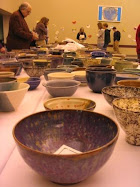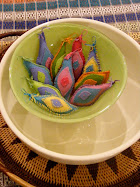~Revisiting a recipe from Monday, January 5, 2009
I posted this recipe over a year ago, and for several months we ate delicious homemade yogurt. Then life intervened and I lost the rhythm, until eventually homemade granola became the weekly handcrafted kitchen item. Today we had extra milk on hand, but only a dollop of yogurt, so I decided to revive the craft, as part of a rainy Sunday afternoon.
I had to call up that old post to review, so I'll paste it in below. I don't divide the quantities into two bowls covered with plastic wrap (as the recipe recommends) but place everything into a retro covered earthenware pot that is the perfect size for making a quart of yogurt.
Like any other culinary practice, this isn't hard to do, once you get the hang of it. I never lose the Voila! feeling, either, when I open the pot and see the warm transformed milk.
If you have a penchant for the denser Greek-style yogurt that is now all the rage, just strain the finished product for a few hours or overnight. It will then have a thicker consistency, one that a friend of mine says reminds her of (chocolate) mousse.
This thicker yogurt becomes yogurt cheese the drier it becomes, and can be used as a substitute for milk, sour cream, quark, or even crème fraiche (or clabber) when cooking or baking.
Greek yogurt has more concentrated protein and fewer carbs than the average American yogurt. It also contains less lactose, the sugar in dairy products that some people find difficult to digest. With any yogurt, though, the goal should be to find or make a product that is unadulterated. Add your own fresh herbs, fruits, honey or jam to flavor your yogurt, or simply eat it straight up. I avoid the wasteful little cups of yogurt that line so many dairy cases, especially those high offenders laced with additives, sugar, and gelatin. Make your own to pack smaller portions in small reusable containers if taking yogurt for lunch.
One note about the whey that is left behind when you strain yogurt: it is incredibly nutritious, so think twice before you simply discard it. Whey helps regulate spikes in blood sugar. It is highly "bioavailable" and thought to enter the blood stream faster than other sources of protein – hence the popularity of whey powder substances among athletes. Need a power boost? You can skip the whey powder and just ingest the real thing. (Think buttermilk, or kefir.)
Because of the nutritional value of whey, arguments about the superiority of Greek yogurt over "regular" yogurt are somewhat misleading. The textural and not the nutritional difference is the distinguishing feature between the two. Anyway, here's that recipe, revisited below, and another version available at EllieMay's Blog, where I found the nice photo of yogurt with walnuts.
*****
 Voila! I made yogurt for the first time. I recently found a recipe in ReadyMade magazine that made it sound so easy...and then I found a crock at Goodwill that seemed perfect for the purpose. I have long wanted to make homemade yogurt, and may have even had one of those electric yogurt makers once with the little cups, so many years ago that I don't really recall. In any case, yogurt making never became a practice for me, the way I hope to make it now.
Voila! I made yogurt for the first time. I recently found a recipe in ReadyMade magazine that made it sound so easy...and then I found a crock at Goodwill that seemed perfect for the purpose. I have long wanted to make homemade yogurt, and may have even had one of those electric yogurt makers once with the little cups, so many years ago that I don't really recall. In any case, yogurt making never became a practice for me, the way I hope to make it now.My goal is to free myself from plastic tubs, and to use Organic Valley or Traders Point organic milk, reducing the cost of organic yogurt. And to enjoy the process of transforming one thing to another, an insatiable pleasure.
So now we have 4 cups of fresh homemade organic yogurt in the fridge, with yogurt cheese not far behind. Here is the recipe from ReadyMade. If you travel to where is is archived, you'll find recipes for yogurt cheese and for a chilled yogurt soup.
CULTURE CLUB
Goodbye, plastic tubs! DIY yogurt is as simple as boiling milk
by Scott Hocker
Though yogurt bears a hard-to-shake association with health food stores and college co-ops [HEY, Scott! WTF? Get hip to the co-op, dude!] the creamy foodstuff is a delicious and versatile ingredient in the kitchen. Best of all, it’s ridiculously (and cheap) to make from scratch. All you need is a whole lot of milk, a tiny amount of all-natural store-bought yogurt, and an oven.
INGREDIENTS
1 qt. whole, lowfat, or nonfat milk
1 1/2 tbsp preservative-free, all-natural yogurt
MAKE IT
1. Preheat oven to approximately 200 degrees.
2. Pour milk into a large saucepan and bring to a boil over medium-low heat. A higher flame may be used, but the higher the heat, the more constant stirring is required to ensure the milk doesn’t scorch.
3. When the milk comes to a boil, turn down the heat until the milk is gently simmering. (Careful: milk has a tendency to boil over quickly once it reaches the boiling point.) Let simmer for approximately two minutes.
4. Take the milk off the heat and let cool until the temperature on an instant-read thermometer is between 110 and 115 degrees.
5. In a four-cup bowl, blend yogurt with approximately 1/2 cup of the milk. (Adding some of the hot liquid, but not all of it, keeps the mixture from curdling and killing off the healthy bacteria.)
6. Turn off the oven.
7. Return the yogurt-milk mixture to the saucepan and stir with the remaining milk.
8. Divide the contents between two bowls and cover each with plastic wrap.
9. Place the bowls in the oven and drape a kitchen towel over them.
10. It will take anywhere from 6 to 15 hours for the yogurt to set. If after 6 hours it hasn’t gelled, simply leave the mixture in the oven and check back about every 3 hours.
11. Once it sets, refrigerate. The longer the yogurt sits in the refrigerator, the tangier it will be.








































































































































.jpg)









































































































































.jpg)









































































































2 comments:
I'm so excited to see your post about making your own yogurt! I've been bookmarking diy yogurt recipes but haven't yet taken the plunge. Thanks for sharing your recipe.
Hi Sweetbeets...
It really works! Tell me how yours turns out...
Post a Comment